Caledonian Canal Sailing
After our recent adventure on the much smaller Crinan Canal, it was time for a more famous one – the Caledonian Canal. Almost everyone has heard of it. If not of the canal itself, then certainly of Loch Ness, which forms part of it – along with the legendary creature said to lurk in its depths.
We had planned our Caledonian Canal sailing from the moment we decided to sail to Scotland. The canal not only shortened our route to Norway. Also, it offered a safe alternative to rounding Scotland’s northern tip via the Pentland Firth and Cape Wrath – tricky in the often unsettled spring weather. But above all, it was an attraction in itself!
We won’t repeat the detailed navigation instructions for yachts here. You can find those on the Scottish Canals website, the authority managing the canal. Just like with the Crinan Canal, we’ll share our practical tips and a ready-to-use travel plan. You’ll learn what to expect in the locks and along the route, where to stop, and what’s worth seeing on the way. It is short, complete sailing and sightseeing itinerary you can easily adapt to your own plans.
Because there’s so much to cover, we’ve decided to split this post about the Caledonian Canal sailing into two parts. In Part One, we describe the route from the sea lock in Corpach to Fort Augustus. In Part Two, we’ll continue from Fort Augustus, enter the famous Loch Ness, and sail all the way to Inverness.
Caledonian Canal – General Information
But before we get into the details, let’s start with a few basics!
The Caledonian Canal is 60 miles (97 km) long. It connects the North Sea at Inverness with the Atlantic Ocean at Fort William. Only about 22 miles (35 km) of it are man-made. The rest follows four great glacial lochs: Loch Lochy, Loch Oich, Loch Ness, and Loch Dochfour.
Along the route there are 29 locks, 10 swing bridges, and 4 lifting bridges. The total rise in water level is 32 metres, with the most impressive section being Neptune’s Staircase – a flight of eight interconnected locks that lifts vessels nearly 20 metres.
Day 1 – Caledonian Canal Sailing
Route: Corpach – Banavie
Distance: 1 NM
The Corpach Sea Lock
Our Caledonian Canal sailing adventure begins at the sea lock in Corpach. It’s worth calling ahead to the number listed on the official Scottish Canals website to check lock operation times and let the staff know how many yachts to expect – especially during peak season.
If you arrive early, you have two options: moor outside at Corpach Marina or wait at anchor. Keep in mind, however, that Corpach Marina is not part of the Caledonian Canal. The berth fee is not included in the canal transit charge.
Anchoring in front of the lock is possible, but sailors warn that the seabed is littered with old structures that can easily snag your anchor. It makes the marina a safer choice if you plan to stay overnight while waiting for the next locking.
In our case, we spent the night before entering the canal at the beautiful anchorage in Loch a’Choire. Early in the morning we set off for Corpach, timing our passage to coincide with the Corran Narrows – a tight strait known for its strong currents, eddies, and shallow spots. It’s best to pass about an hour before or after slack water, when the tidal flow is weakest.
We reached Corpach just a few minutes before our scheduled locking. So, we waited drifting in front of the entrance, without dropping anchor. From that moment on, we kept in touch with the lock keepers on VHF channel 74.
Working the Lines on the Caledonian Canal
Although we had our own mooring lines prepared, at this lock – and later at the Gairlochy Lock – the lock keepers threw down their own ropes for us to use. This is a common practice, especially in locks with a large difference in water levels, where passing or tossing your own lines from the deck could be difficult or even unsafe.
Another difference we noticed compared to the Crinan Canal was that on the Caledonian Canal, it’s common practice to tie the running lines. On the Crinan Canal, this was discouraged – even forbidden – because of the risk of the rope snagging or jamming while being eased out. We covered this in detail here.
Corpach Basin
At the first lock, crews receive a map, documents, and – most importantly – a key that grants access to all the facilities along the canal. Don’t forget to ask for it if they forget; it’s hard to get it later. The key must be returned at the final lock in Inverness.
Initially, we planned to spend the night just beyond the sea lock, in Corpach Basin. However, the Caledonian Canal guide advises yachts not to moor there, suggesting instead to continue through the next few locks up to Banavie. In practice, though, the quay was completely empty. It seems that if it’s not occupied by commercial vessels, you can stay there after informing the lock keepers or calling on VHF channel 74.
A stop in Corpach is worth considering, as it’s a convenient place to refuel, take on water, or do some shopping. We decided to continue our Caledonian Canal sailing, passing two more locks before proceeding along the canal to Banavie.
Neptune’s Staircase
Ahead of us lies the famous Neptune’s Staircase! Although it was only 2:00 p.m. (the canal operates from 09:00–16:00 in winter, 08:30–17:30 in spring and autumn, and 08:00–18:00 in summer), we were informed that there would be no further upward lockings that day through this spectacular flight of eight locks.
We moored on the right side of the canal, just before the Banavie Bridge and the Staircase itself. That’s where we spent the night – marking the end of our first day on the Caledonian Canal.
At this spot, shown on the canal map as “Banavie Jetty”, there are no facilities (no electricity, water, or showers). You’ll find those after passing Neptune’s Staircase, in the area marked Banavie Top Basin.
Lord of the Glens
But the attractions don’t end there! While Tranquility rests peacefully at the pontoon, our Caledonian Canal sailing adventure continues. Just ahead of us, descending through Neptune’s Staircase, is the largest and most luxurious cruise ship navigating the Caledonian Canal — the Lord of the Glens.
This elegant cruise liner fits almost perfectly into the locks. It’s about 45 metres long and 10.4 metres wide, which is exactly the canal’s maximum limit. The entire locking process takes around 90 minutes, and watching it is truly impressive.
Interestingly, Lord of the Glens was rebuilt in 2000 specifically to navigate the Caledonian Canal and fit through its narrow locks. Today, it remains the only luxury cruise ship that regularly sails the entire route from Inverness to Fort William.
It quickly becomes clear that this vessel sets the rhythm of the entire canal – it always has priority, and the schedule of lock operations and passing points is adjusted to its timetable.
If you’re not sailing your own boat, a cruise on the Lord of the Glens is definitely worth considering – it’s a unique way to experience the Caledonian Canal “from the inside,” without the work of handling lines and locks. You can find more information about the ship and its voyages at lordoftheglens.co.uk.
Besides the Lord of the Glens, many other tourist vessels operate along the Caledonian Canal, including the Fingal of Caledonia, Spirit of Scotland, and the fast Beastie Boats, which offer tours and activities like kayaking or cycling. You can also rent a motor cruiser from companies such as Le Boat or Caley Cruisers and explore the canal independently — no licence required! Operators provide a short training session before departure, covering everything you need to know.
Neptune’s Staircase
Stopping near Neptune’s Staircase—whether before or after the flight of locks—is always worth it. It gives you time to admire this engineering marvel from both the water and the shore.
Neptune’s Staircase is the most famous part of the Caledonian Canal, and the longest lock system in the UK. It’s made up of eight linked chambers. Together they lift or lower boats by almost 20 meters over a distance of just a quarter of a mile. The system was designed by the Scottish engineer Thomas Telford and opened in 1822, after nearly twenty years of work on the canal.
Today, the locks run on hydraulic power. Long ago they were operated by hand—hard to imagine when you stand beside them. The place still works every day and draws crowds of sailors and tourists. Yes, tourists! While you lock through, you’ll have spectators on the path above. Sometimes even full tour groups stop to watch the whole process.
It’s one of those rare spots where history, engineering, and everyday sailing life meet in one scene.
Before taking Tranquility through Neptune’s Staircase, we wander along the shore and look at it from dry land. Tomorrow we’ll enter the system, but today we simply admire it in peace.
Hogwarts Express
Another highlight in this area is the Banavie bridge, just below Neptune’s Staircase. The bridge itself isn’t the real attraction here — it’s the train that crosses it: the famous Hogwarts Express, well known to every Harry Potter fan. This is the West Highland Line, the route where the iconic steam locomotive heads into the Highlands and later crosses the Glenfinnan Viaduct, made legendary on screen.
With a bit of luck (and by checking the timetable), you can watch the train from your boat or from the quay in Banavie. It glides across the bridge in a cloud of steam, with the mountains behind it, and for a brief moment the scene feels almost unreal. It’s one of those small, charming moments that make the Caledonian Canal feel magical. And this won’t be our last encounter with the Hogwarts Express on this journey.
When the day is done — after locks, steam trains, and Highland views — it’s worth stopping by The Lochy, a nearby pub. It’s a great spot to slow down, enjoy something local, and recharge before the next stage of the trip… and the next round of line handling in the morning.
Ben Nevis Hike
If Caledonian Canal sailing still isn’t enough adventure, there’s also Ben Nevis — the highest mountain in the United Kingdom (1,345 m). It stands only a few kilometres from Corpach, towering over Fort William and the surrounding glens. Many sailors take a break from the water and head up for a day in the hills.
The challenge, however, is getting to the start of the trail. Whether you begin in Corpach or near Neptune’s Staircase, you’ll need a couple of transfers to reach the Glen Nevis Visitor Centre, where the most popular route starts. It sounds close, but in practice — with bus schedules and waiting times — it turns into a full-day operation. For us, the logistics, combined with a very early last return bus, were reason enough to give it a pass. The only realistic alternative is a taxi.
Our Scottish friends also advised us against the climb. Ben Nevis can be extremely crowded in the season, with hundreds of hikers reaching the summit every day. The view from the top is spectacular, no doubt. But you’ll find equally beautiful panoramas — and far quieter trails — throughout the Highlands, without all the logistical hassle. So if you’re seeking peace and mountain solitude, it’s better to choose a lesser-known route. But if your dream is to stand on “the roof of Britain”, nothing will stop you. 🙂
Day 2 – Caledonian Canal Sailing
Route: Banavie Jetty – Laggan Locks
Distance: 15 NM
Transit Through Neptune’s Staircase
After admiring the famous flight of eight locks from the shore, the next morning it was finally time to take our boat through it. We checked in on channel 74 to find out the planned locking time and prepared to enter the first chamber. The opening of the Banavie bridge is coordinated with the lock operation, so everything moves as one sequence.
Once you pass the first lock going up, it’s common practice for one crew member to step ashore and lead the boat “on a leash” through the remaining chambers. This saves a lot of effort — you don’t have to keep throwing and catching lines over such short distances. Depending on how many yachts are going through, the job falls entirely on the crew member on land, though sometimes the lock staff lend a hand too.
Neptune’s Staircase in Practice
In our case, Tomek stayed on board, and I went ashore to lead the boat with the bow line. At each chamber, I was quickly hooking the line, then running to the stern to take the stern line from Tomek and pass it back down to him. As the water level rose, Tomek was adjusting the stern line from the deck, while I was doing the same with the bow line from shore.
When the lock filled and the gates opened, the stern line went back on board, and once again I stayed on land with the bow line, walking the boat to the next lock. And so it went — eight times in a row! Toward the end, a friendly member of the canal staff joined us and took over the stern line, which made the whole process much easier.
The crew member on shore also has another, slightly less obvious job: talking to tourists and answering an endless stream of questions. As I mentioned earlier, Neptune’s Staircase is not just an attraction for sailors, but for visitors from around the world. You’ll meet guided groups and curious travellers who want to know what it’s like inside the lock, ask about the boat, or find out where you’re sailing next.
Thanks to all that activity — lines, teamwork, running back and forth and conversations — the two-hour passage through Neptune’s Staircase doesn’t feel long at all.
Midges — Scotland’s Most Deadly Creatures
The weather at Neptune’s Staircase was typically Scottish — one moment sunny, the next rainy. But what bothered us more than the changeable skies were the Scottish midges — tiny flies that swarm and bite every exposed patch of skin.
Fortunately, we got lucky. Even though we were bitten, we didn’t have allergic reactions, unlike many other people who would swell up and turn bright red.
We definitely recommend having insect repellent — especially for the crew member who goes ashore, but really for anyone heading to Scotland. Midges can strike anywhere! While we didn’t experience anything extreme, the stories we heard sounded straight out of a horror movie.
Locally, some specific remedies are recommended — including Smidge or… a perfumed Avon spray “Skin So Soft”, which midges supposedly hate. We stuck to standard insect sprays based on DEET from our yacht supplies, and they worked just fine. As I mentioned, we seem to have quite a bit of resistance to their bites.
Gairlochy Lock
After passing through Neptune’s Staircase, we continued our cruise up the canal. If you feel like taking a break, just beyond the flight of locks there are pontoons with full facilities — bathrooms, electricity, and water.
The next “obstacle” is the Moy swing bridge, which also has pontoons on both sides — in case you need to wait for it to open. After that comes Gairlochy — again a bridge and two locks. In practice, the first lock is often left open: you pass through the swing bridge and immediately enter the second lock.
Gairlochy has the highest water level difference on the entire canal — perhaps because that first lock is almost always open. Once moored inside, you really feel tiny. Tall concrete walls and steel gates rise all around, people on the shore are barely visible, and the roar of the water drowns out everything else.
Because of the height, lines are thrown down to us from above — there’s no way they could be handed up from the deck, even if someone could throw a long way! We stand just in front of the massive lock gates, water swirling turbulently around us, while we work the lines to keep the boat in place. With the number of yachts around, it’s quite tight.
Loch Lochy
After leaving the locks at Gairlochy, the first lake on the canal opens up ahead — Loch Lochy. Its name is a bit curious, because if you translate it literally, it would be “Lake Lake”.
The weather is on our side, so we set the sails and enjoy the Scottish scenery. It’s the perfect moment to relax — locking through, especially with a small crew, can be really tiring! At the south-western end of the lake there’s an anchorage where yachts often stop.
We, however, take advantage of the wind and the beautiful weather, planning to pass through Laggan Locks the same day, located between Loch Lochy and the next lake, Loch Oich.
Laggan Locks
Just before Laggan Locks there are pontoons where you can wait for the locks to open, and on their northern side you’ll find extra mooring spots. We pass through the locks and stop for the night just beyond them, on the right-hand side of the canal.
As we tie the last line, a formation of Red Arrows — the UK’s most famous aerobatic team — flies low overhead. Well, exactly as we’d requested! 😉
Around Laggan Locks you’ll find all the facilities you need: water, electricity, bathrooms, trash containers, and picnic areas. It’s a very popular spot for a stopover and a peaceful night’s stay.
Eagle Barge Inn
Undoubtedly, a major attraction near Laggan Locks is the pub on a barge moored at one of the pontoons — the Eagle Barge Inn. This unique vessel has its own story — it was originally a Dutch transport barge, later converted into the only floating pub on the Caledonian Canal. Today, it’s a cult meeting spot for sailors, cyclists, and travellers exploring the canal.
Visiting this pub was one of the most enjoyable experiences on the Caledonian Canal — and it wasn’t just about the drinks. It’s the atmosphere that makes it special. The interior of the barge, full of wood, brass details, and nautical touches, creates a warm, cozy vibe — perfect for a break after a day on the water.
The pub is seasonal, usually open from mid-March to mid-October. Hours can vary depending on the weather and tourist traffic, so it’s worth checking ahead before visiting. It’s closed on Mondays and Tuesdays, so plan your passage accordingly if you want to stop by. And believe me – you want it! If you’re planning to eat in addition to enjoying some Scottish beer, you’ll need to reserve a table and dinner in advance. Highly recommended!
We stayed longer at Laggan Locks — and not just because of the pub moored right behind our stern!
Day 3 – Caledonian Canal Sailing
Laggan Locks and Ben Tee hike
At Laggan Locks, our friends join us again. They’ve clearly developed a taste for sailing the Scottish canals ever since they came with us through the Crinan Canal! This day, we don’t plan to move the boat anywhere — the pontoon at Laggan Locks is the perfect base for a mountain hike.
On the north-west side of the canal stretches a mountain range, with several peaks over 900 m. Many of them are so-called Corbetts — Scottish mountains between roughly 762 m (2,500 ft) and 914 m (3,000 ft). We decide on Ben Tee hike.
From Laggan Locks, we first follow the road to Kilfinnan, where the trail up to the summit begins. From the yacht moored at Laggan Locks, it’s about 13.5 km of walking with nearly 900 m of elevation gain. The trail is straightforward but boggy — typical for Scotland. Its start winds through overgrown slopes — a perfect opportunity to pick up a few ticks.
Right at the beginning, in Kilfinnan, we come across a strange sight: the body of a dead, shot wild boar lying by the road. Even our Scottish friends agree this is unusual — wild boars are rare in this area, it’s not hunting season, and certainly nobody leaves an animal right by the road. We do, however, remember hearing gunshots the day before while sailing Loch Lochy… I’ll spare you a photo of this discovery.
From the summit of Ben Tee, the views are fantastic — just like anywhere in the Scottish Highlands. You can see a large stretch of the Caledonian Canal, including the famous Loch Ness, which we’ll reach soon. To the south, Ben Nevis emerges from the clouds, and to the north, wild, rugged mountain ranges stretch out. We highly recommend this hike to anyone sailing the Caledonian Canal.
We found this route, like many others in Scotland, through Walkinghighlands website, which is an incredible resource for hiking trails.
After the mountain hike, we spend the evening — naturally — back at the Barge Inn pub!
Day 4 – Caledonian Canal Sailing
Route: Laggan Locks – Fort Augustus
Distance: 9 NM
Loch Oich
Time to move on! Just one swing bridge separates us from the next lake, Loch Oich. It’s a very small, narrow, and shallow lake, with a marked channel running almost its entire length. According to the Scottish Canals guide, there are a few possibilities for anchoring along the lake’s edges. Based on our maps, however, we skip them — they seem too shallow, and the weather doesn’t really encourage going ashore anyway.
Invergarry Castle
Still, we recommend considering a stop at Castle Bay, at the northern end of Loch Oich — either at anchor or at a small pontoon that can fit up to two yachts. From here, you can see the ruins of Invergarry Castle — once the seat of the MacDonell clan of Glengarry. Though partially destroyed in the 18th century, its walls still rise above the shore of Loch Oich, mysteriously entwined with wild ivy and lichens, as if nature is slowly reclaiming it.
Aside from the weather, we were also discouraged by the information that the castle grounds are fenced off, so even seeing it from the outside wasn’t possible. Perhaps that will change one day.
Loch Oich is also the highest point of the Caledonian Canal (32 m above sea level), so from the next locks down to Fort Augustus, we’ll be descending.
Fort Augustus
From the Scottish wilderness, greenery, and solitude, we suddenly arrive in the very heart of mass tourism. Fort Augustus is the main base for trips on Loch Ness — it’s from here that excursions and cruises set off in search of the famous Nessie. At first, we don’t even have a clear plan for a stop; we consider going through the flight of five locks later the same day. The decision, however, is made for us by heavy rain. We moor in front of the locks at “Large Craft Jetty” – as other spaces were full, ending our sailing for the fourth day.
Despite the weather, we bundle up in our foul-weather gear and head into town. The sheer number of tourists quickly overwhelms us — organized tours from Asia, Nessie souvenirs, the bustle and noise. This time, we couldn’t escape mass tourism, though we usually try to. So, we sip overpriced coffee in a touristy café, nibble on an equally overpriced cookie, and head back to the boat as fast as we can.
As it turns out, we made the right choice staying in front of the locks. Familiar crews who have gone through the locks and are moored below have literally a promenade on the quay — zero privacy and zero peace.
Part 1 – Summary
And so, on the forth day of our transit along the Caledonian Canal, we reached the gates of the famous Loch Ness. You will soon read about sailing on the lake, local attractions, and the continuation of the canal in Part Two, covering the section from Fort Augustus to Inverness and the canal exit.
We hope you’ll stay with us as we continue our journey through the Scottish Highlands. And if you have any questions about the Caledonian Canal — don’t hesitate to contact us!
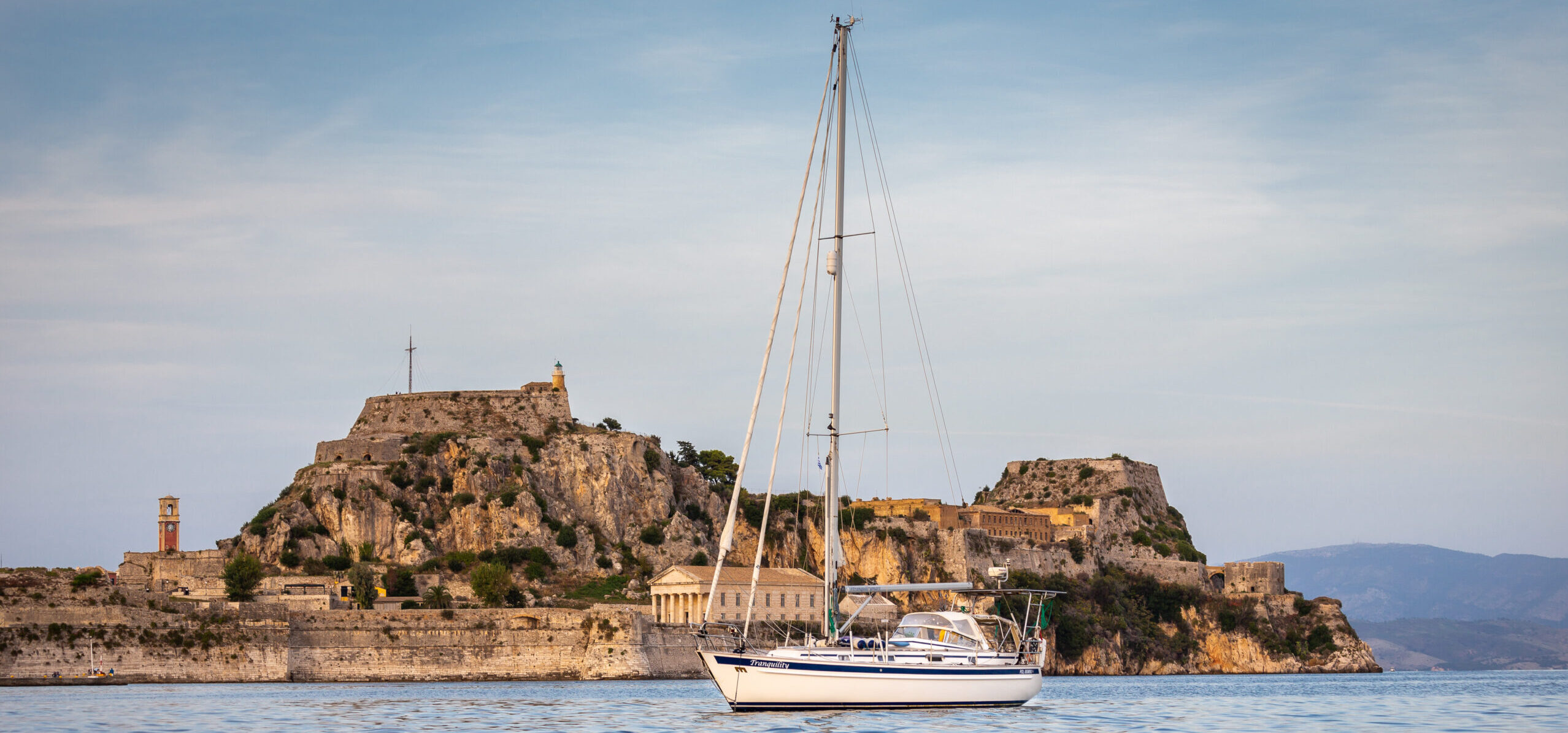
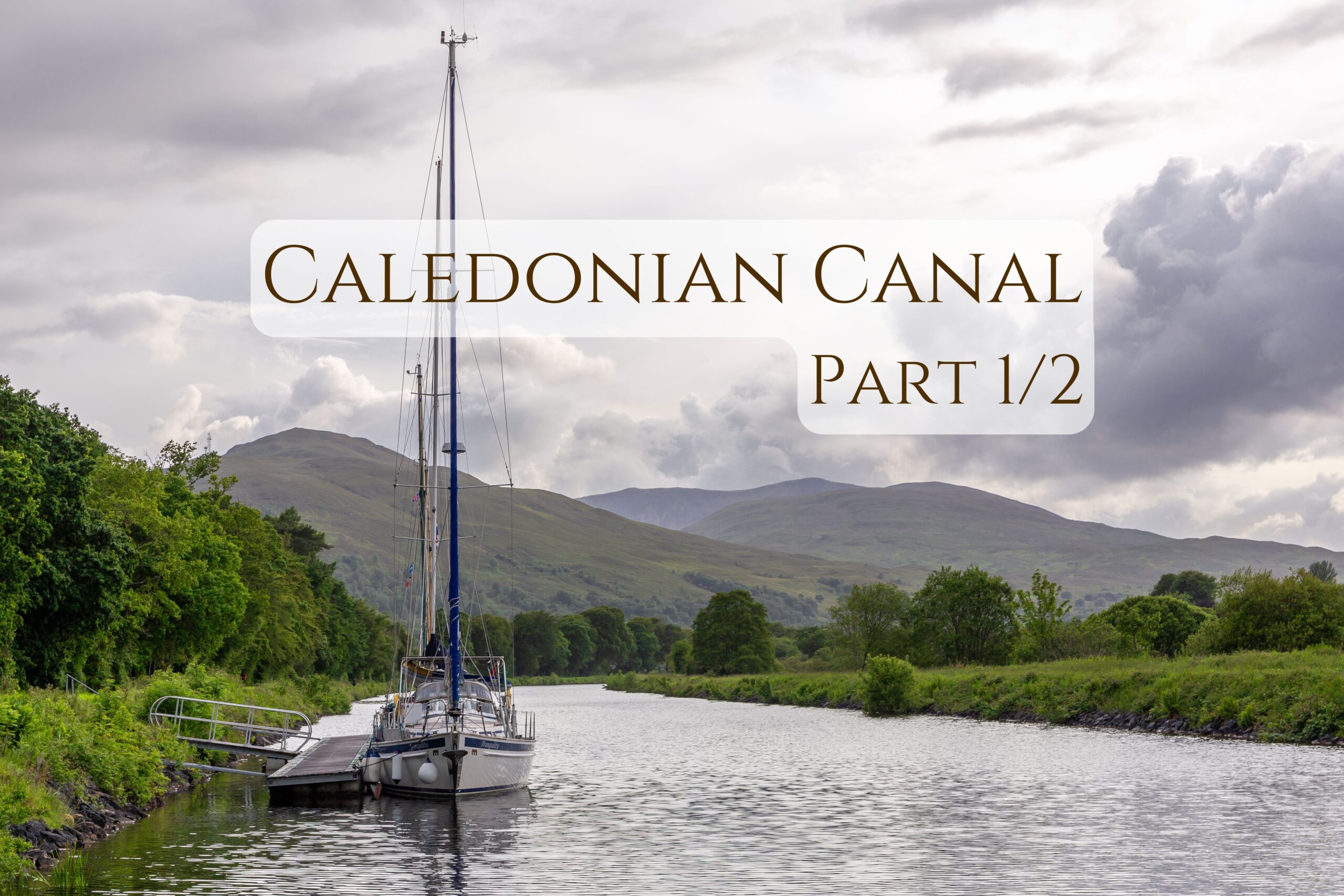
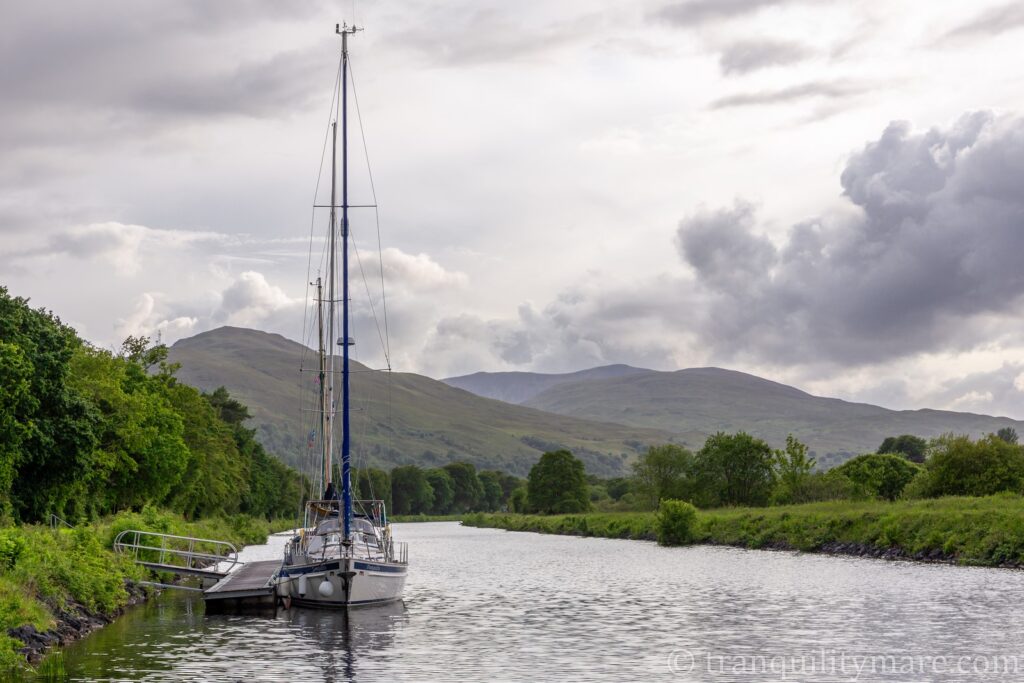
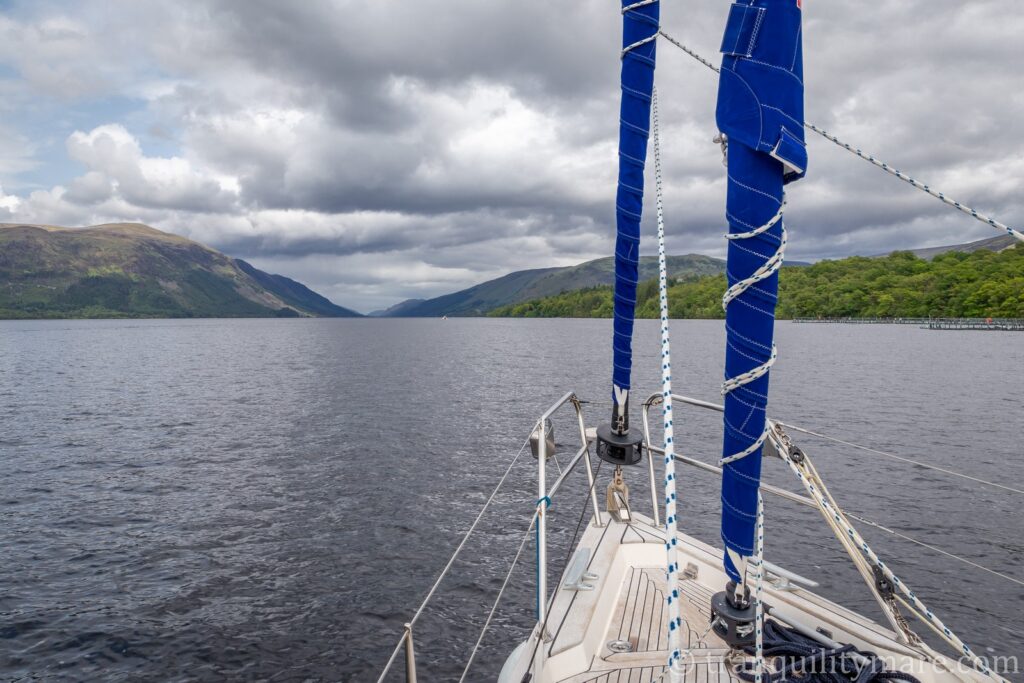
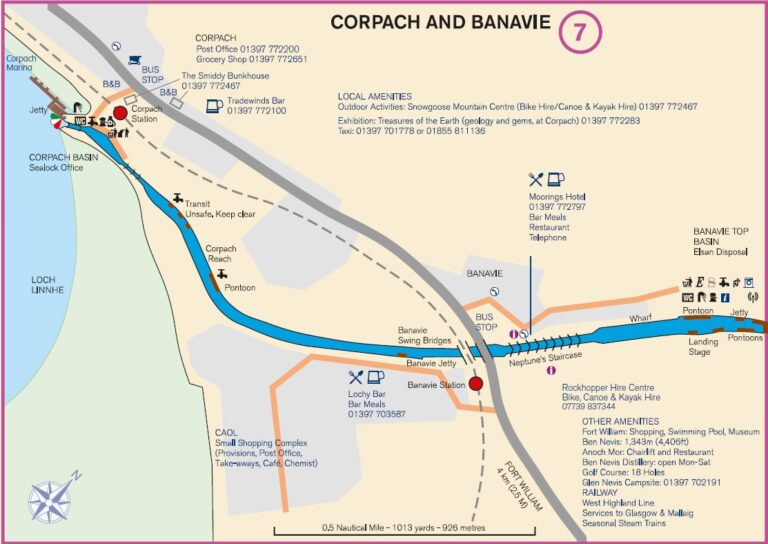
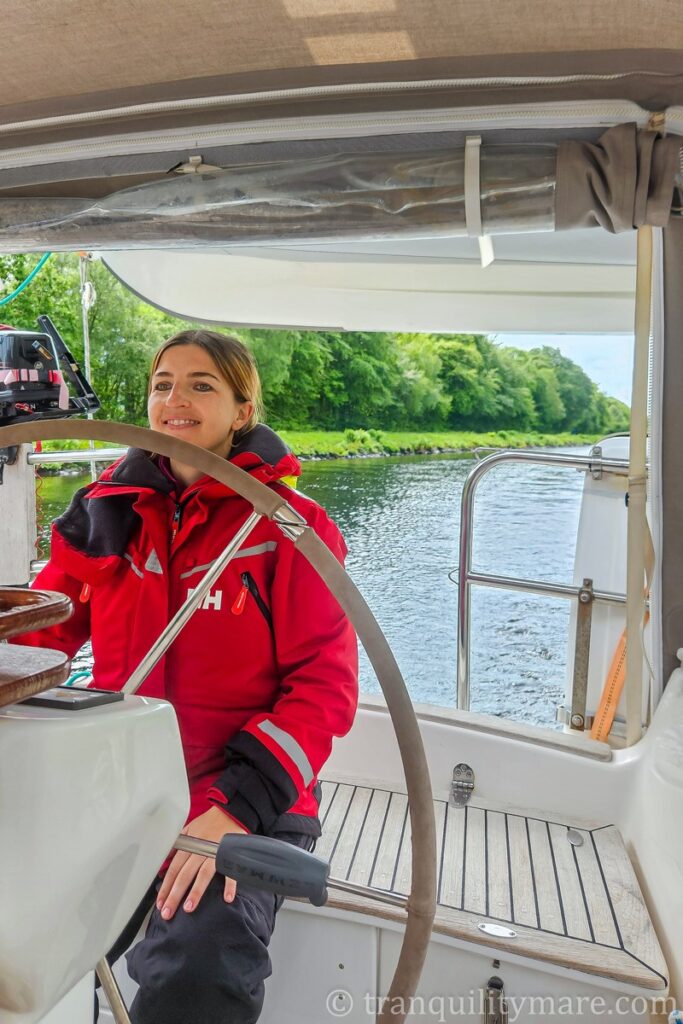
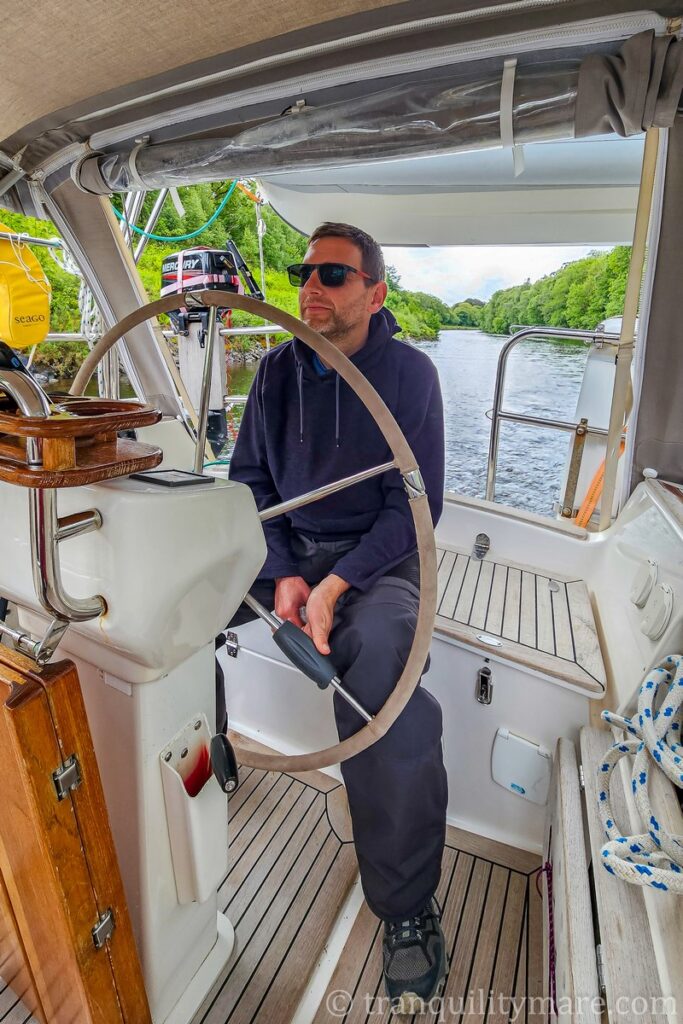
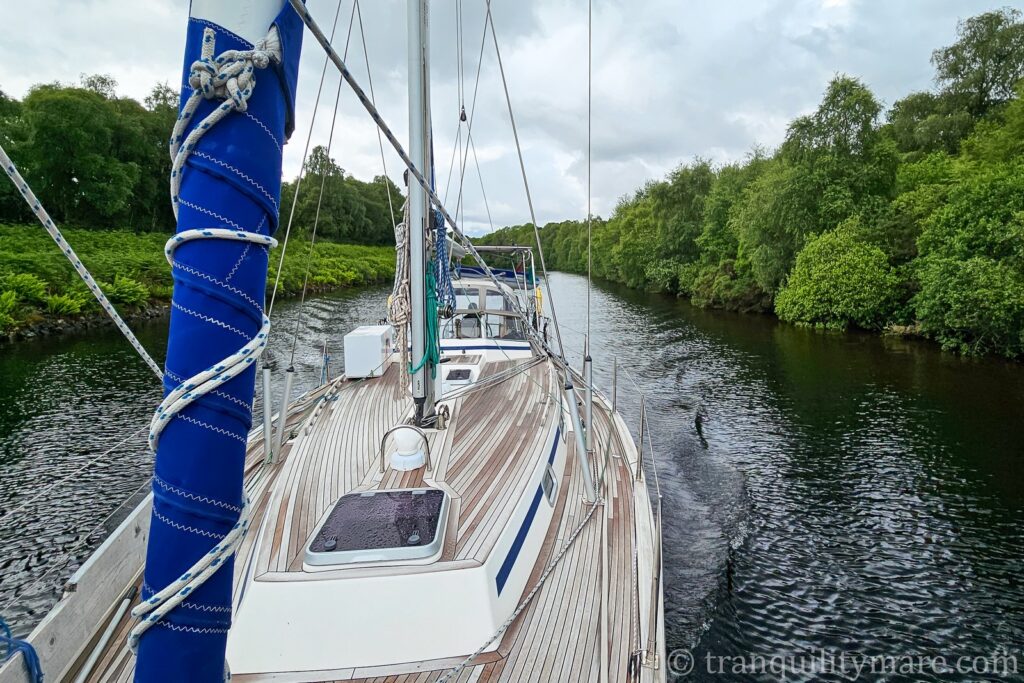
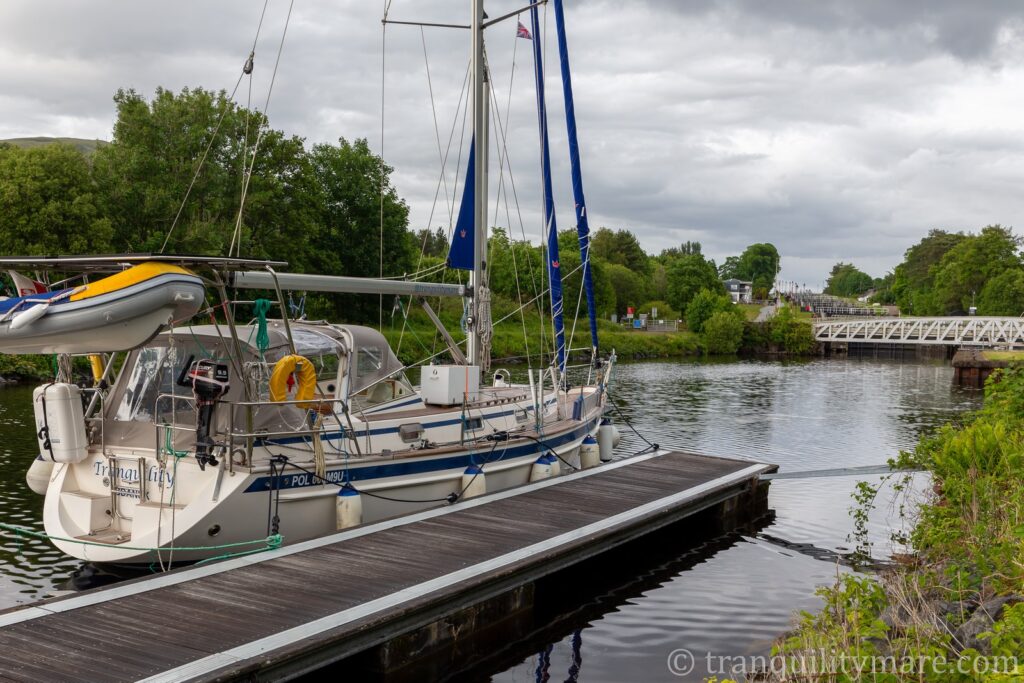
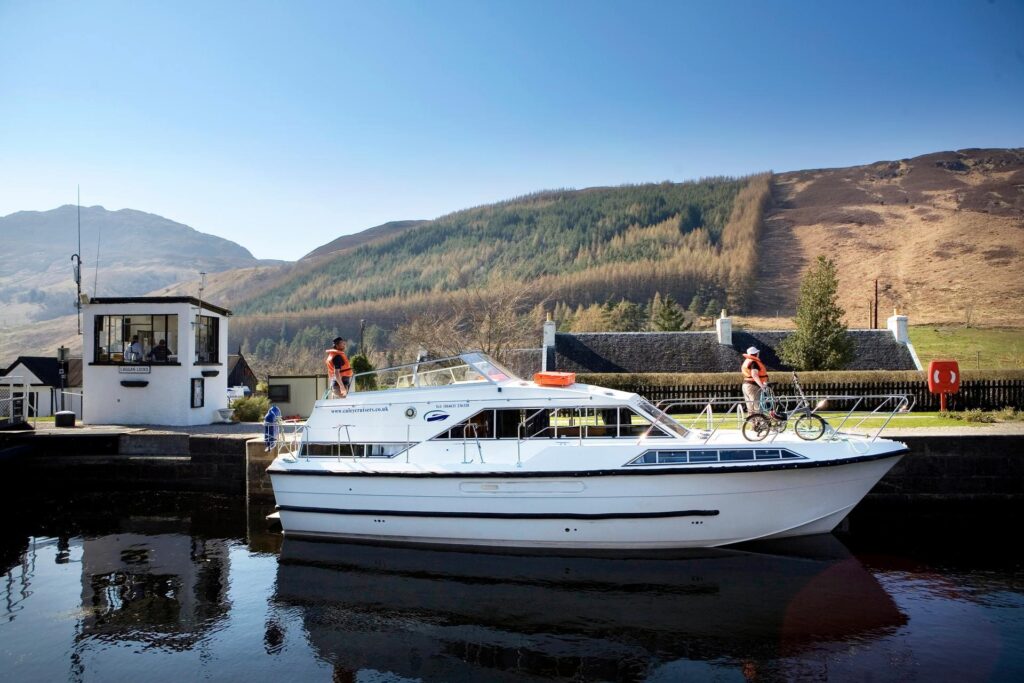
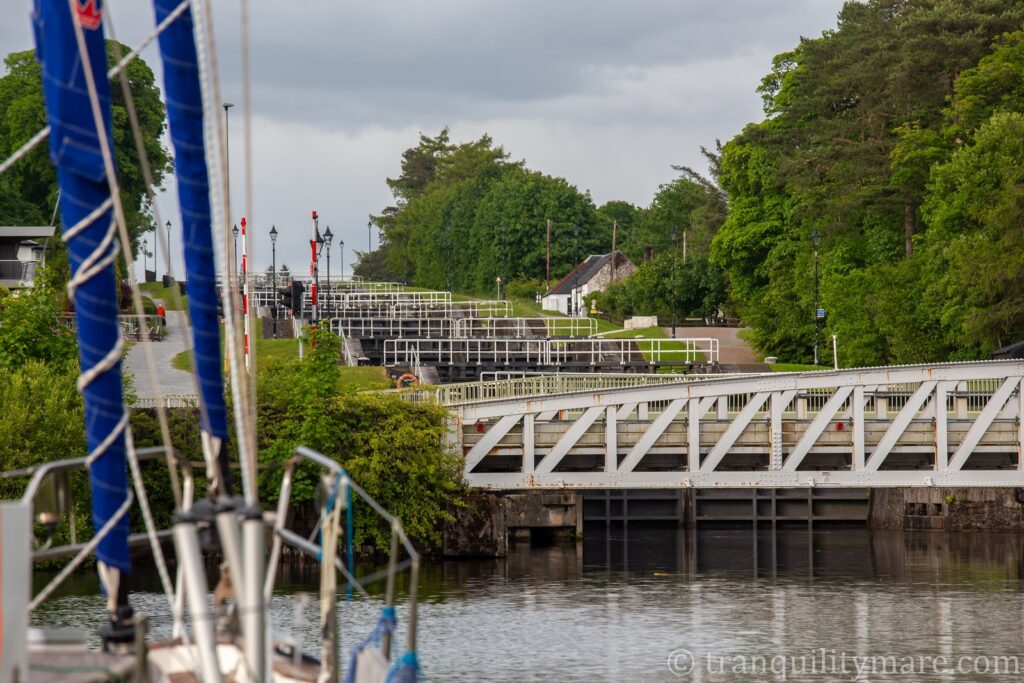
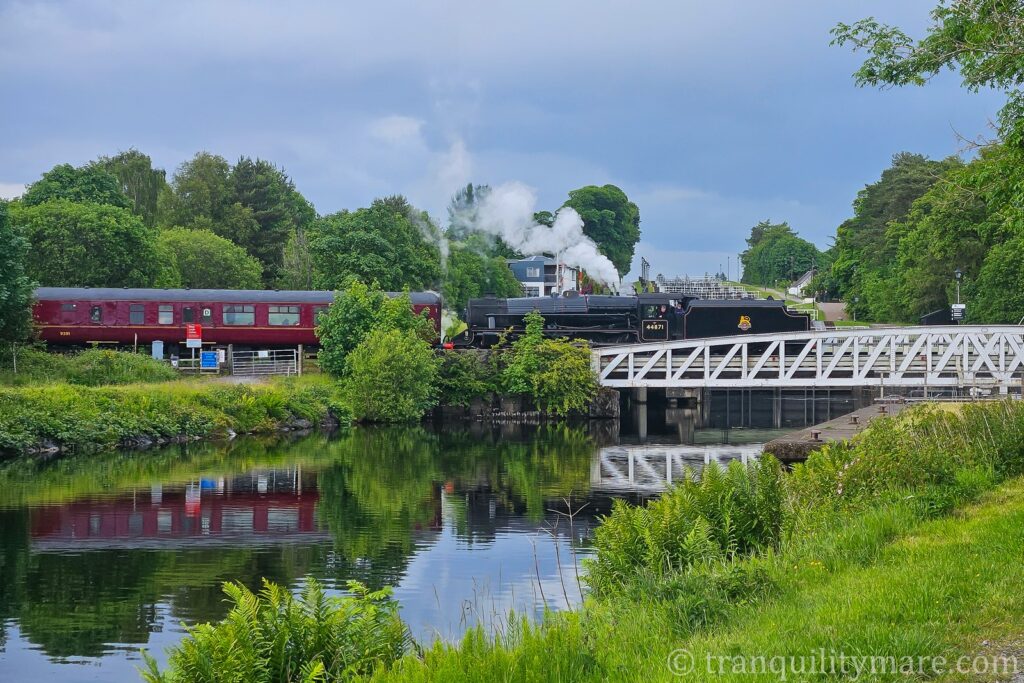
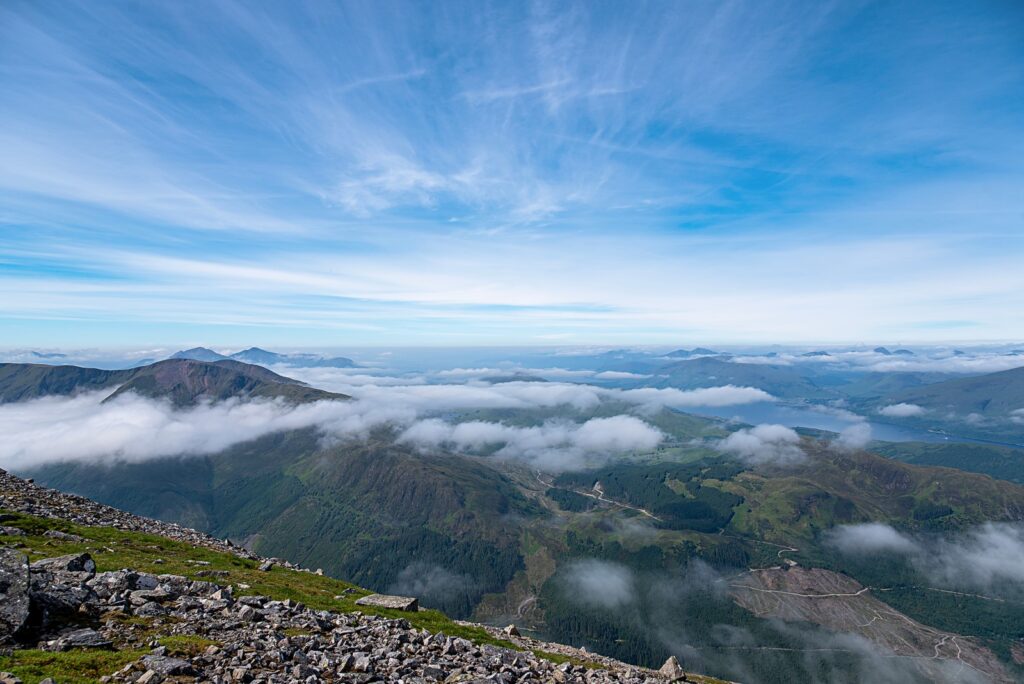
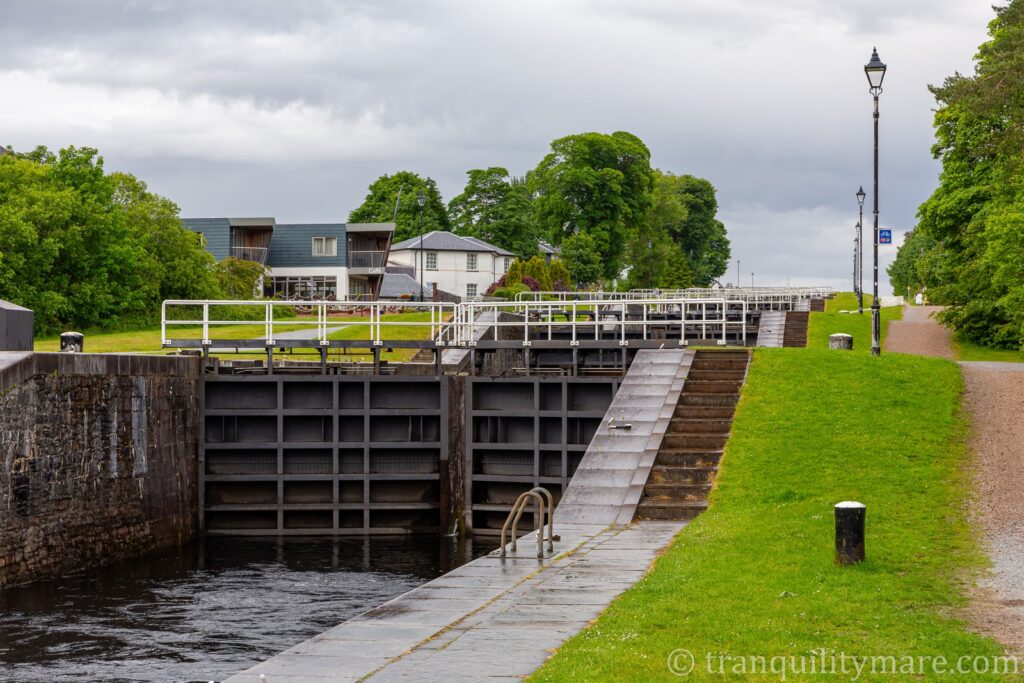
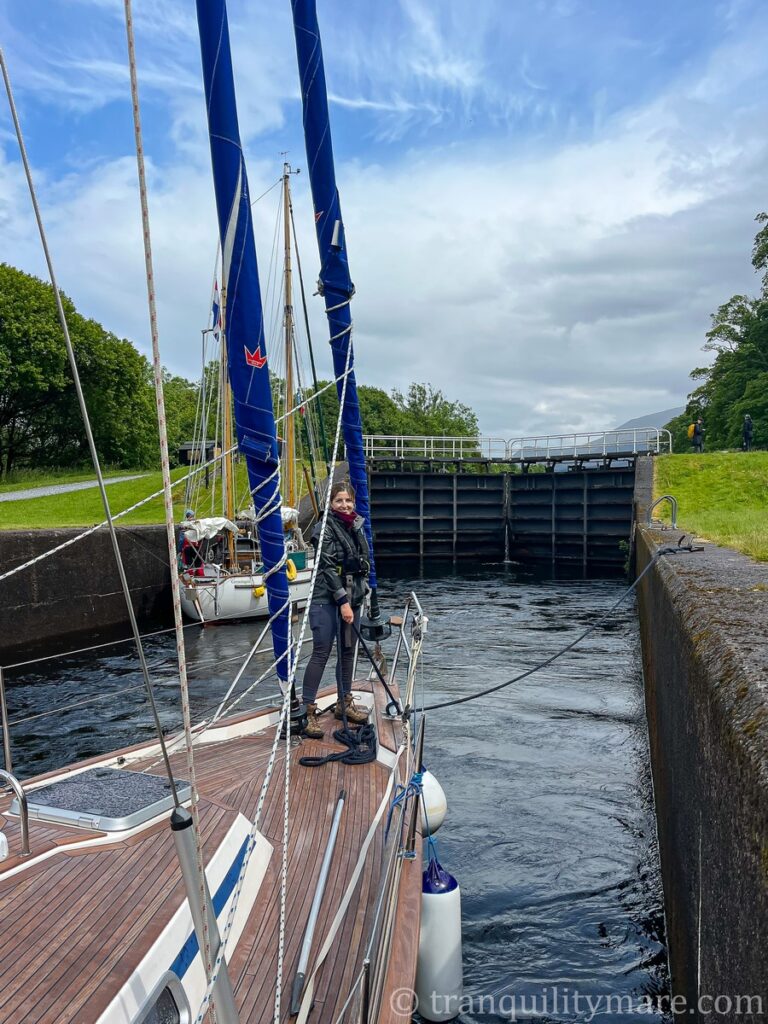
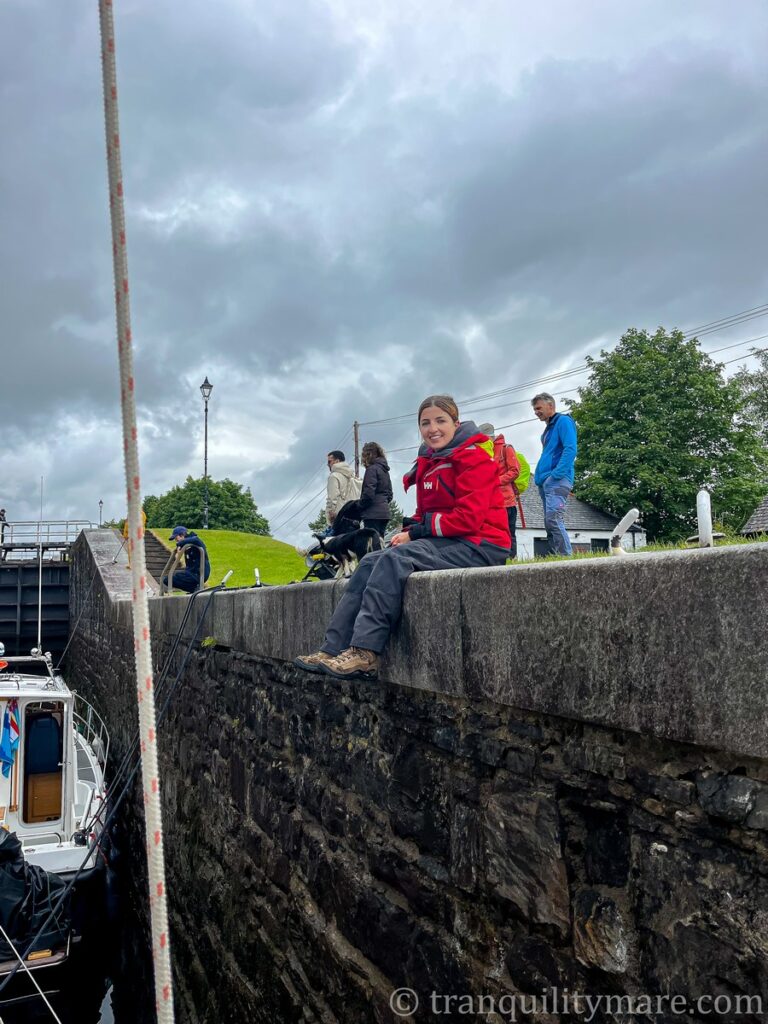
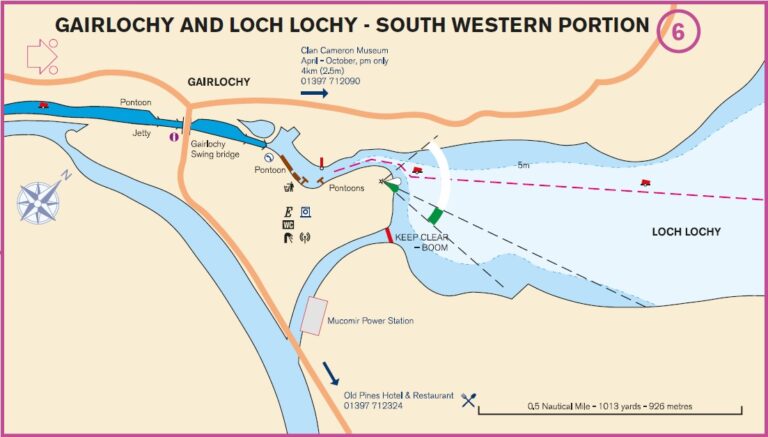
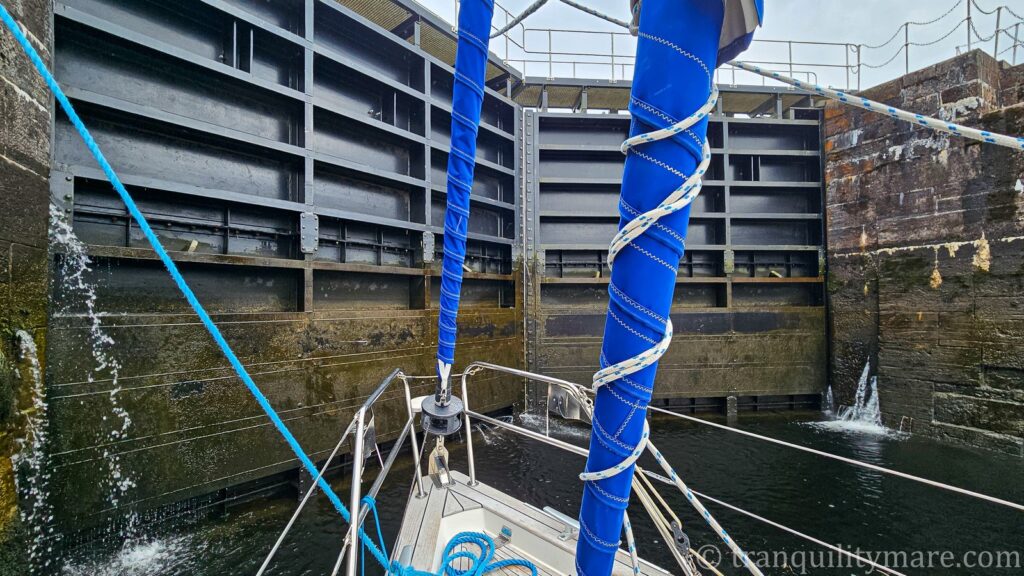
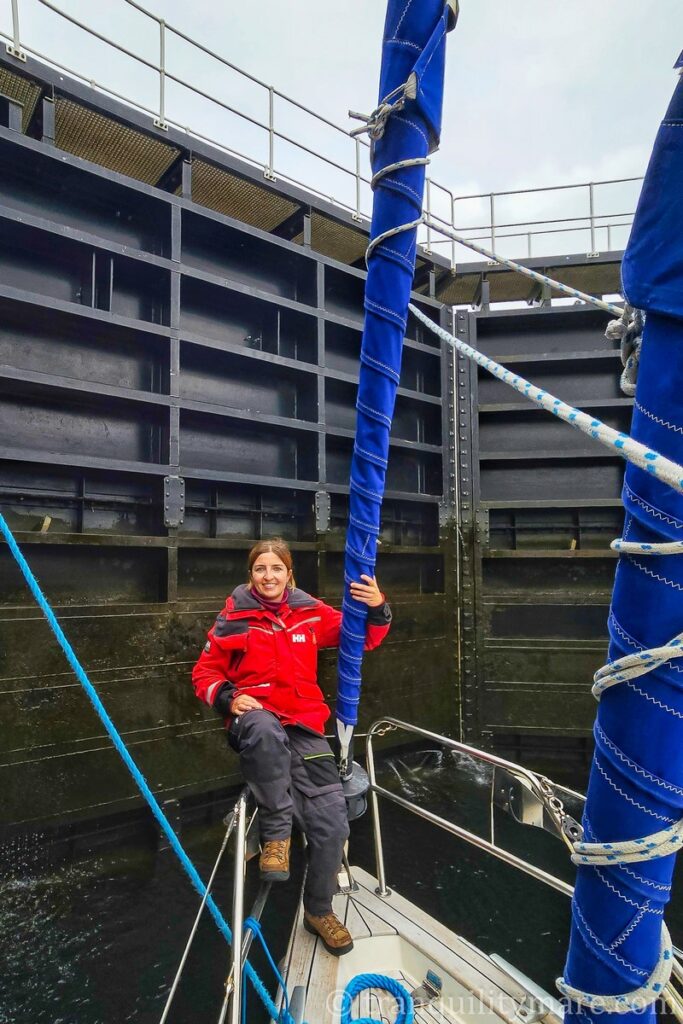
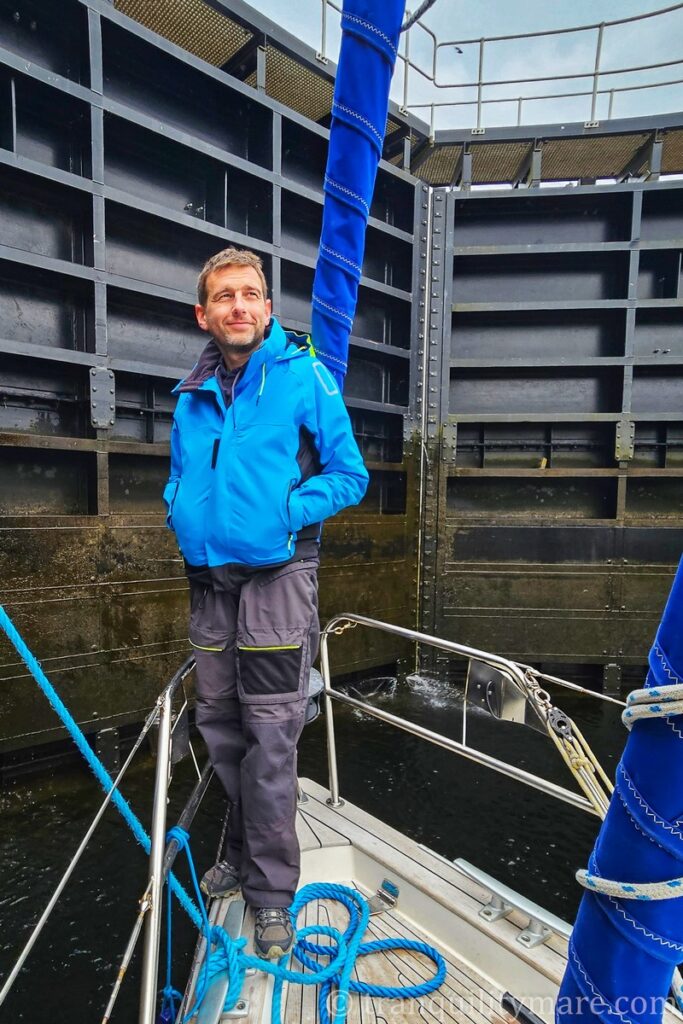
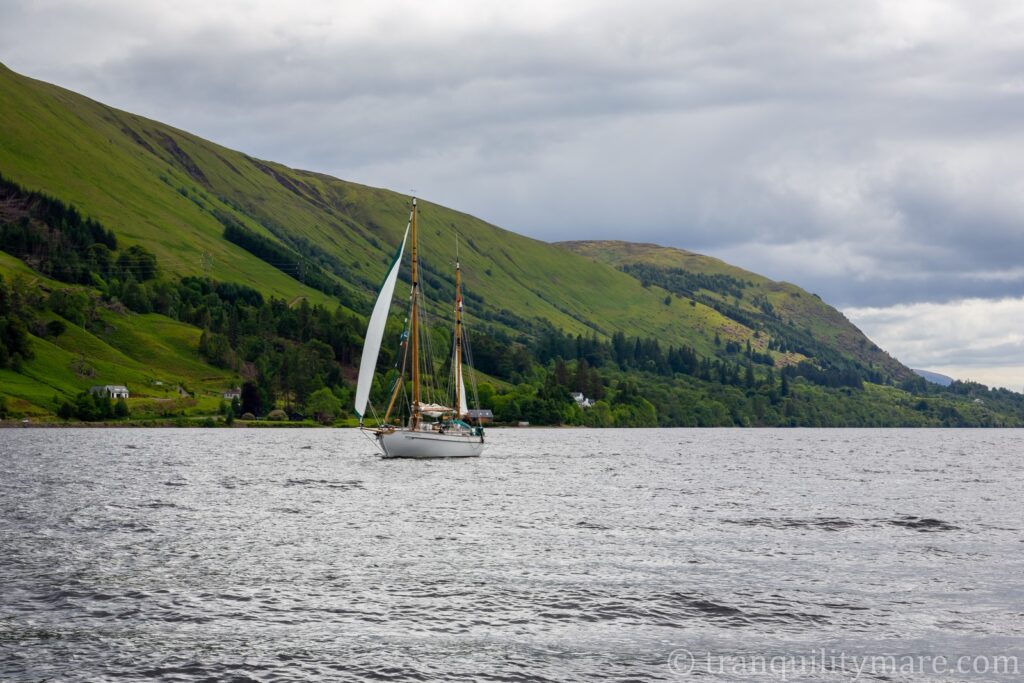
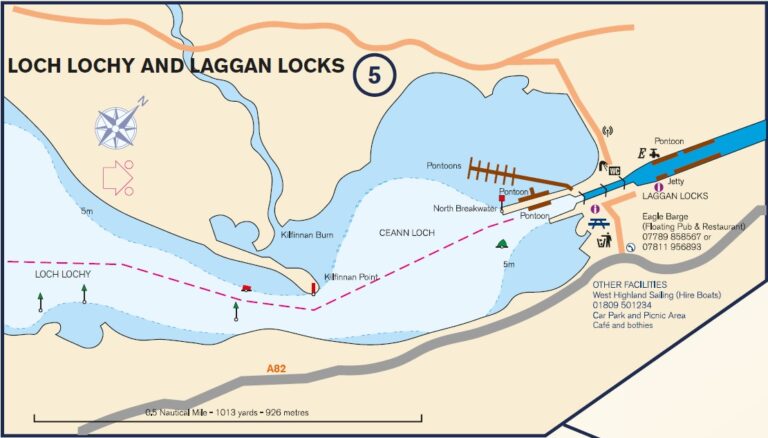
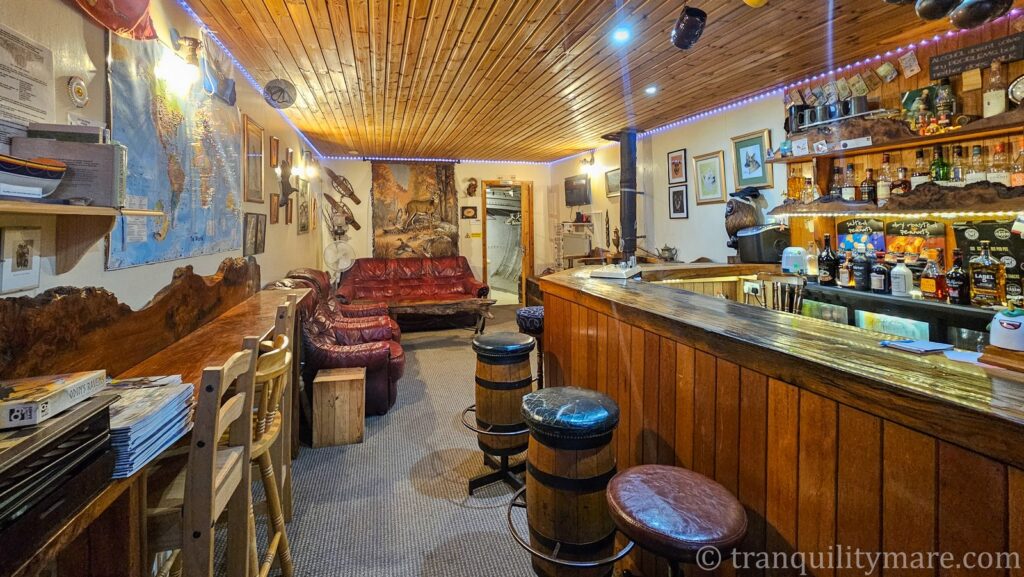
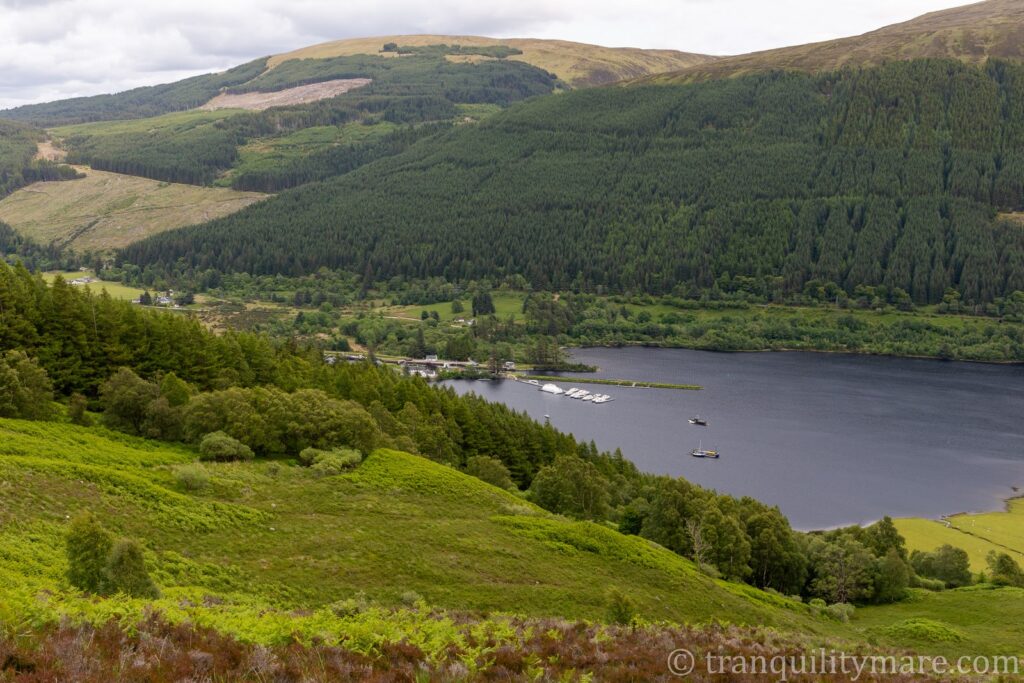
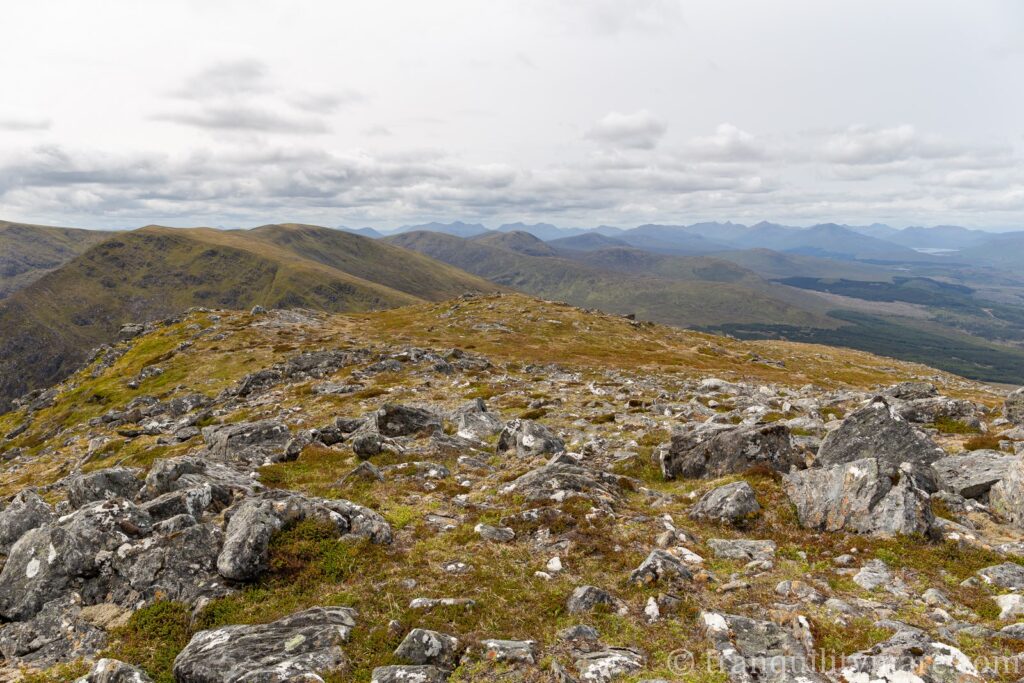
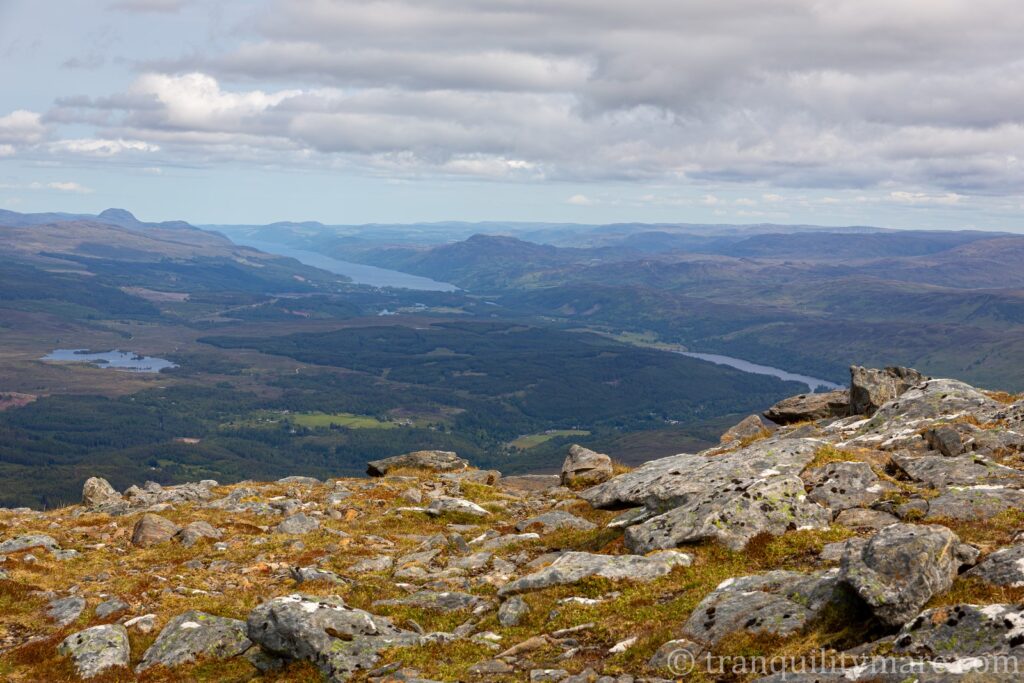

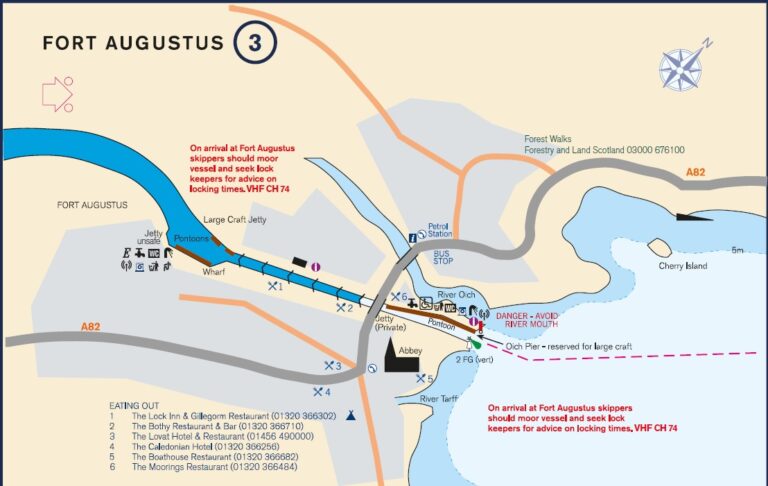
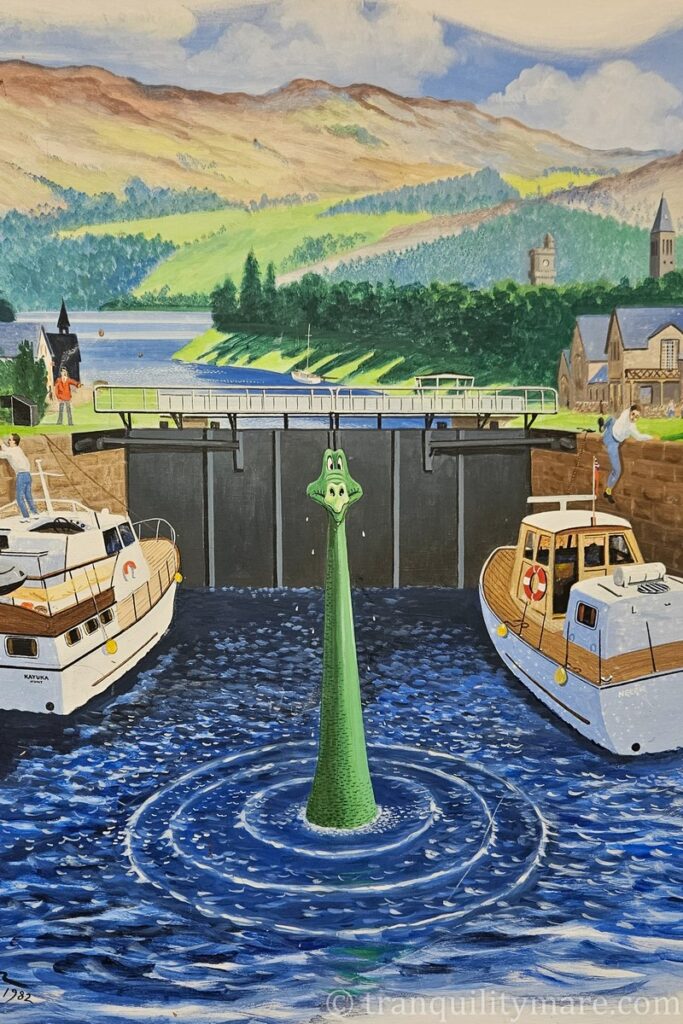

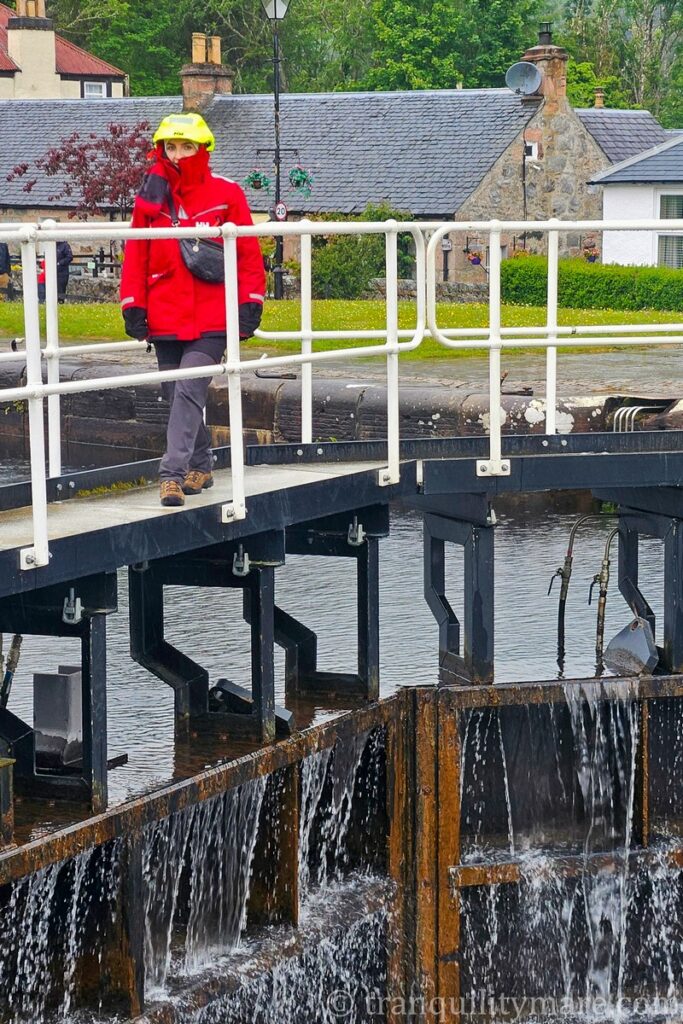



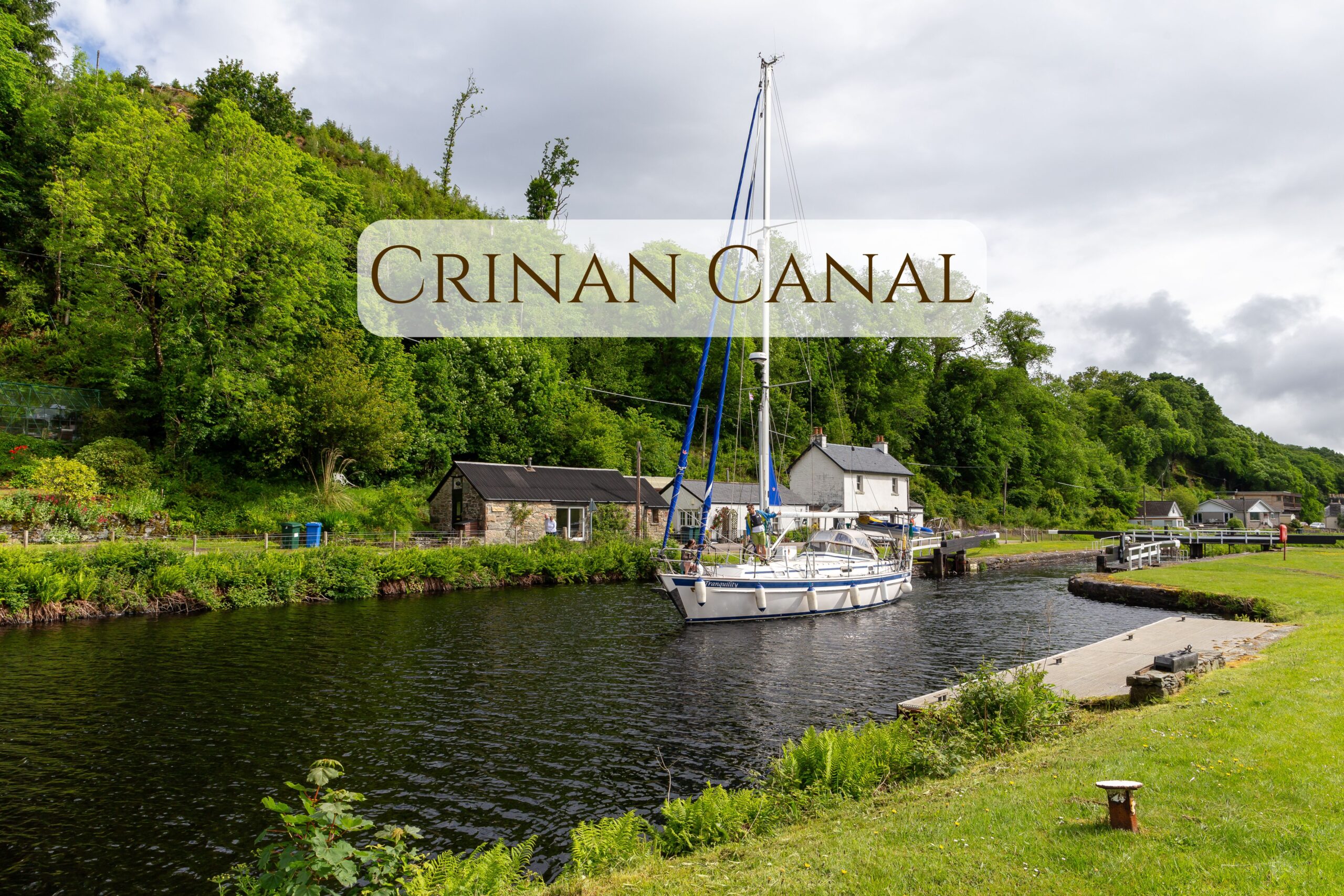
No responses yet